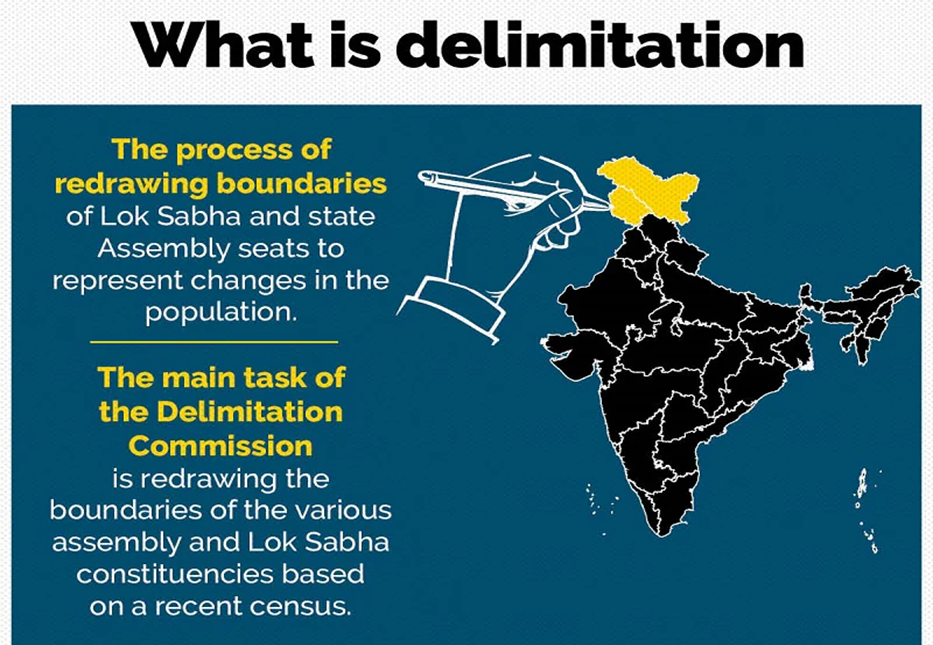Note4Students
From UPSC perspective, the following things are important :
Prelims level: Delimitation Commission
Mains level: Role of delimitation in preserving political equality

Central idea
Key Highlights:
- Political Equality in Liberal Democracies: In liberal democracies, political equality extends beyond the opportunity to participate; it includes ensuring that each citizen’s vote holds equal value.
- Types of Dilution: Quantitative dilution is observed when population deviations among constituencies result in unequal representation. Qualitative dilution, on the other hand, occurs through gerrymandering, impacting the chances of minority representation.
- Constitutional Safeguards: Articles 81, 170, 327, 330, 332 of the Constitution establish safeguards to guarantee political equality. They empower Parliament to enact laws related to delimitation and address concerns of both quantitative and qualitative dilution.
- Role of Delimitation Commissions: Delimitation commissions, formed periodically, play a crucial role in maintaining population-representation equality by adjusting constituency boundaries.
Key Challenges:
- Population Growth Disparities: Unequal population growth among states poses a challenge, leading to quantitative dilution where the weight of votes varies significantly.
- Impact of Gerrymandering: Gerrymandering can qualitatively dilute the value of votes, particularly affecting minority representation. Techniques like cracking, stacking, and packing can be employed to manipulate electoral boundaries.
- Issues with Freezing and Variation Allowance: The freezing of population figures and the allowance for a 10% variation have resulted in imbalances, allowing deviations from the ideal population-representation ratio.
Key Terms and Phrases:
- Dilution Types: Understanding the distinctions between quantitative and qualitative dilution is essential for addressing challenges in the democratic process.
- Legal Framework: Key legal terms include gerrymandering, the Delimitation Commission, Two Member Constituencies (Abolition) Act, 1961, 42nd Amendment Act, 1976, and the Sachar Committee Report, which provide the foundation for delimitation processes.
Key Quotes:
- “The right to vote can be diluted quantitatively and qualitatively by redrawing constituency boundaries.” – Pamela S. Karlan This quote emphasizes the importance of maintaining the integrity of the voting process and avoiding dilution through boundary manipulations.
- “Delimitation of constituencies needs to be carried out regularly based on the decennial Census.” Regular delimitation, aligned with the decennial Census, is crucial for adapting to demographic changes and ensuring fair representation.
Key Statements:
- Population Growth Variations: Differences in population growth among states create a significant gap in the value of votes, impacting the democratic principle of equal representation.
- Issues with Freezing and Variation Allowance: The freezing of population figures and the allowance for variation contribute to imbalances in representation, requiring careful consideration in the delimitation process.
Key Examples and References:
- Impact of Delimitation on SC-Reserved Seats: Delimitation’s impact on Scheduled Caste (SC)-reserved seats, especially concerning the majority Muslim population, highlights the complexities of fair representation.
- Discrepancies in Muslim Representation: Discrepancies between the percentage of Muslim MPs in Parliament (4.42%) and their overall population (14.2%) underscore the qualitative dilution in the representation of minority communities.
Key Facts and Data:
- Population Growth Between 1971 and 2011: Disparities in population growth across states, with some experiencing over 125% growth, contribute to the quantitative dilution of votes.
- Representation Disparity: The average representation disparity, where an MP in some states represents significantly more people than in others, reflects the challenges in achieving equal representation.
Critical Analysis:
- Threats to Democracy: Both quantitative and qualitative dilution pose significant threats to the democratic process, undermining the principle of equal political representation.
- Challenges with Freezing and Variation Allowance: The freezing of population figures and the allowance for variation may result in continued imbalances, demanding a critical evaluation of the current delimitation framework.
- Impact on Minority Representation: The qualitative dilution of votes has a notable impact on minority representation, requiring a nuanced approach in delimitation to address these disparities.
Way Forward:
- Urgent Delimitation: Urgent delimitation is necessary to rectify population-representation deviations and uphold the principles of equal representation in a timely manner.
- Comprehensive Delimitation: Future delimitation processes must consider both quantitative and qualitative aspects, ensuring a comprehensive approach to achieve fair representation.
- Protecting State Interests: Special attention is required to protect the interests of states with slower population growth, balancing the need for representation across regions.
- Continuous Monitoring and Adjustments: Regular monitoring and adjustments in delimitation processes are essential for maintaining a robust and inclusive democratic system. Continuous adaptation to demographic changes will help address evolving challenges in representation.
Get an IAS/IPS ranker as your 1: 1 personal mentor for UPSC 2024

